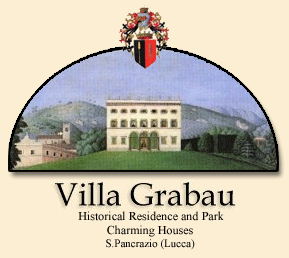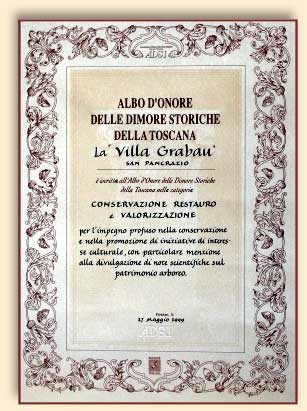
History:

The registration was made in March 1999
through the
attention of a judging
Committee presided over by the
Tuscan Region and the Historical
Italian Residences'
Association
On the ground floor the first flight of the Main Staircase, made of Matraia stone, was moved from the central ball-room to the western side of the house, so as to create a separate entrance. Then the large open Arcade, to the south of the Villa, was closed with glass window frames and "Trompe l'oeil" curtains were painted decoratively on the walls, together with Frescoes representing dancing nymphs and geometrical designs; this gave to the drawing-room a neo-classical appearance, and was called the "Hall of false curtains".
The "Trompe l'oeil" paintings were executed with such realism that they have deceived many connoisseurs over the years.The only room which remains untouched from the 17th century with its original frescoes is the little Chapel on the ground floor. On the first floor the coffer ceilings were covered up with canes, then plaster, and lastly they were painted, together with walls, with brightly coloured frescoes inspired by the same classical taste.
The original hut style roof assumed the present hip roof style, while the large Baroque clock, dated 1784, was removed from the top of the original façade and was moved to Villa Orsetti in Palaiola where it is still today. A row of marble busts was placed decoratively along the top of the new roof line so as to show themselves towards the main gate.
In 1868 the Villa was purchased by the wealthy German banker Rodolfo Schwartze for his wife Carolina Grabau, so as to allow her to live near her sister Costanza married to the Baron Wilhelm Hüffer who had just bought the nearby Villa Diodati, and next to her brother Carlo Luigi Grabau who was a very estimated painter of the "Macchiaioli" circle and lived in the nearby Villa Palmata.
Their father, who was of noble German extraction, Carlo Grabau, was born in Hamburg in 1784; he was then transferred in 1832 to Livorno by the Granduke of Tuscany and appointed to be General Consul for the Anseatic Cities of the Northern Sea. He then married Enrichetta Inghirami, from a noble patrician family of Volterra. The Schwartze family had no children, so Villa Grabau was passed down to Carolina's nephew, Marcello Grabau.
This gentleman married later the Countess Francesca Cenami Spada, a noble Patrician of Lucca, and had five children. The Villa then passed to their son Ludovico, and now belongs to his son and daughter, Federico and Francesca.
![]()
![]()
